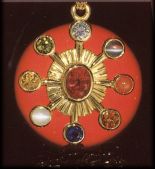|
|
|
|
| For
Countless centuries, the cultures of India and South-East Asia have revered the
beautiful nine-gem talisman known as 'Nava-Ratna'.
Combining the gemstones representing each of nine planets in sidereal
astrology, the 'Nava-Ratna' is esteemed by ancient
tradition as a bringer of good fortune through its favourable influence on the
planetary energies.
|
|
|
|
|
| The
most well-known design places a ruby, representing the sun, in the center
encircled by eight other planetary gem-stones. Diamond for Venus, pearl
for Moon, coral for Mars, hessonite for Rahu, blue sapphire for Saturn, cat's
eye for Ketu, yellow sapphire for Jupiter and emerald for Mercury. |
|
 |
Sapta-Ratna,
the seven jewels talisman, combines the gem which correspond to the planets
ruling the seven days of the week. Every day of the week is governed over
by a specific planet. In English we must simply examine the Anglo-saxon origin
of the names of the days to see the correspondence, Sunday(sun), Monday(moon),
Saturday(Saturn) remains same. Tuesday(Mars), Wednesday(Mercury),
Thursday(Jupiter), Friday(Venus). The
sapta-ratna should be used as seven different rings or pendants to worn
successively on each corresponding day of the week. This practise is still
popular in India, especially among astrologers, royal families and wealthy
people.
|
|
| Pancha-Ratna
combines the gemstones which represent a balance of five material elements.
Thus earth is represented by the green in emerald, water by blue in sapphire,
fire by red in ruby, air by the yellow in topaz, space by the absence of
color in diamond. Another combination of the five gems has been described
as gold for earth, pearl for water, ruby for fire, blue sapphire for air, and
diamond for space. |
|
|
|
|
|
| The
Tri-Ratna is a talisman believed to balance the three constituents of one's
material body, crudely translated as marrow, mucus and air. These are
represented by three primary cosmic colors in nature - red, yellow and blue, or
ruby, red coral and yellow sapphire. |
 |
| Nava-Ratna |
| Bona fide Vedic reference
regarding the Nine Planetary Gems, The quote attributed in sanskrit in
'Brihat Jatak' Manikyam
dinanayaksya vimalam muktaphalam, shitagoh maheyasya cha vidruman
marakatam saumyasya-garutmakam, devejyasya cha pushparagam sura-achryasya
vajram shaneh nilam, nirmalamanyayoshcha gadite gomedh-vaiduryake.
|
| Translation: The
Sun's gem is pure ruby, Moon is (natural) pearl, Mars is red coral, Mercury is
emerald, Jupiter is yellow sapphire, Venus is diamond, Saturn is blue sapphire,
Rahu is hessonite, and ketu is cat's eye. |
|
|
|
|
|
|
 |
|
|
|
|
|